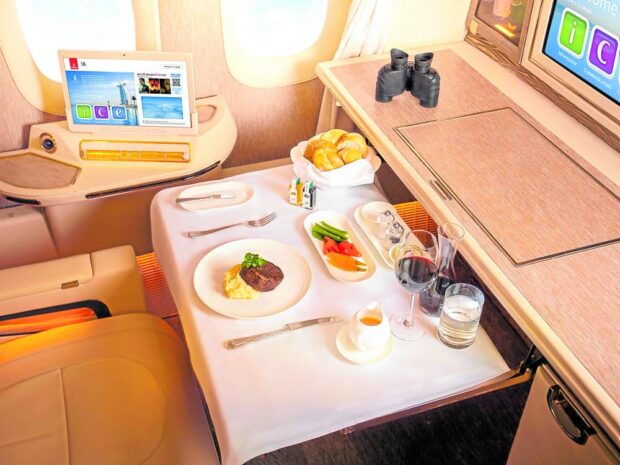Emirates to add wings for Philippine market

TRAVEL IN STYLE What a first-class cabin looks like —Contributed photos
Dubai-based carrier Emirates is set to fly more frequently into Philippine airspace as passenger flow now exceeds prepandemic volume amid the resurgence of international travel and tourism.
“The future looks very bright for the travel industry,” Emirates country manager Saeed Abdulla Miran says in an interview with the Inquirer.
Starting November, Emirates—popular among local passengers traveling to the Middle East and Europe—is set to increase flights out of Ninoy Aquino International Airport to 21 weekly from 18 at present. Including the daily circular service for the Cebu and Clark gateways, this will increase from 25 to 28 Emirates’ weekly flights for the Philippine market.
“We are on that level of prepandemic [period] and a bit more,” Miran says. “Our flights are extremely busy with a seat factor of 94 percent.”
Seat factor refers to the percentage of available seating capacity that has been filled with passengers.
“We will be receiving some newer aircraft as well for the Philippine market,” he says.
33 years in PH
Miran says Emirates’ optimism is based on data showing that the Philippines is one of the destinations favored by international tourists. At the same time, revenge travel after the long lockdowns has continued among Filipinos.
He agrees that tourism may contribute around 8 percent to the domestic economy this year.
Ranked by Skytrax among the world’s top airlines, Emirates has served the Manila route since 1990, connecting to more than 140 countries from its hub at the Dubai International Airport.
It started servicing Cebu and Clark in 2016.
Emirates, one of the two flag carriers of the United Arab Emirates aside from Abu Dhabi-based Etihad, employs around 5,000 Filipinos, including pilots, flight attendants and ground crew. The full-service airline operates 260 aircraft around the world (249 of which are passenger jets) and is expecting delivery of 200 more. It boasts of the world’s largest fleet of wide-body Boeing 777 and Airbus A380 aircraft that offer spacious cabins.
“We are committed to the market for over the 30 years, where we contributed to the economic growth of Philippines,” Miran says.
Emirates caters to three local passenger segments: leisure travelers, business travelers and overseas Filipino workers, including maritime crew.
The country deploys more than 400,000 Filipino seafarers on average each year, based on 2016 to 2021 data from the Maritime Industry Authority. This makes Filipino seafarers the backbone of the global maritime industry.
For holidaymakers, Miran says Europe is a popular destination, particularly the cities of London, Paris, Milan and Rome. Business travelers also typically fly to and from Europe, as well as some of the Gulf Cooperation Council states like UAE.
The affluent passenger market is also a key business driver for Emirates.
“The premium categories, since we introduced them in Manila, they’re doing extremely well. And we are expecting it to keep on doing that because we are one of the few airlines that are offering first-class seats out of Manila,” Miran says.

Saeed Abdulla Miran
Price trend
Based on its online booking portal, a first class Emirates Manila to Paris round-trip ticket currently costs around $7,200. For the same route, it charges around $3,300 for business class while the lowest basic economy fare is around $800.
“If we speak about prices, it’s mainly driven by demand and the availability. If the demand is there, the prices will stay up a bit. There are also external factors that contribute to it; one of it is the fuel price, which is going up,” Miran explains.
Compared with prepandemic prices, Emirates’ fares have gone up but have not strayed too far from past levels.
Will fares go down starting 2024 as various airlines increase capacity? Miran says it will depend on many factors, including demand and fuel prices. “Fuel price is getting higher, so for sure, our price will go up. And if we speak about the demand, flights are extremely busy, so the demand is there. And that’s why our prices are a bit higher than before,” Miran says.
With aviation fuel prices remaining high, Miran says, “I doubt the prices will go any lower because the cost is going up.”
Crude oil prices have remained high at around $85 per barrel at present, with the recent turmoil in oil-rich Middle East arising from the Israel-Hamas war adding to uncertainties already caused by the Russia-Ukraine war.
Notwithstanding cost pressures, Miran is happy with how the airline has been able to grow its business here in the last 33 years.
“We have been committed to offer an exceptional travel experience to Filipinos, both on air and ground, and we have our inflight entertainment system that has more than 6,500 channels. We have our food menu that keeps on changing by seasons and we have been offering premium drinks on our aircraft,” he says. “So we have been giving them the exceptional experience and we are always listening to what our customers need and we adapt accordingly.”